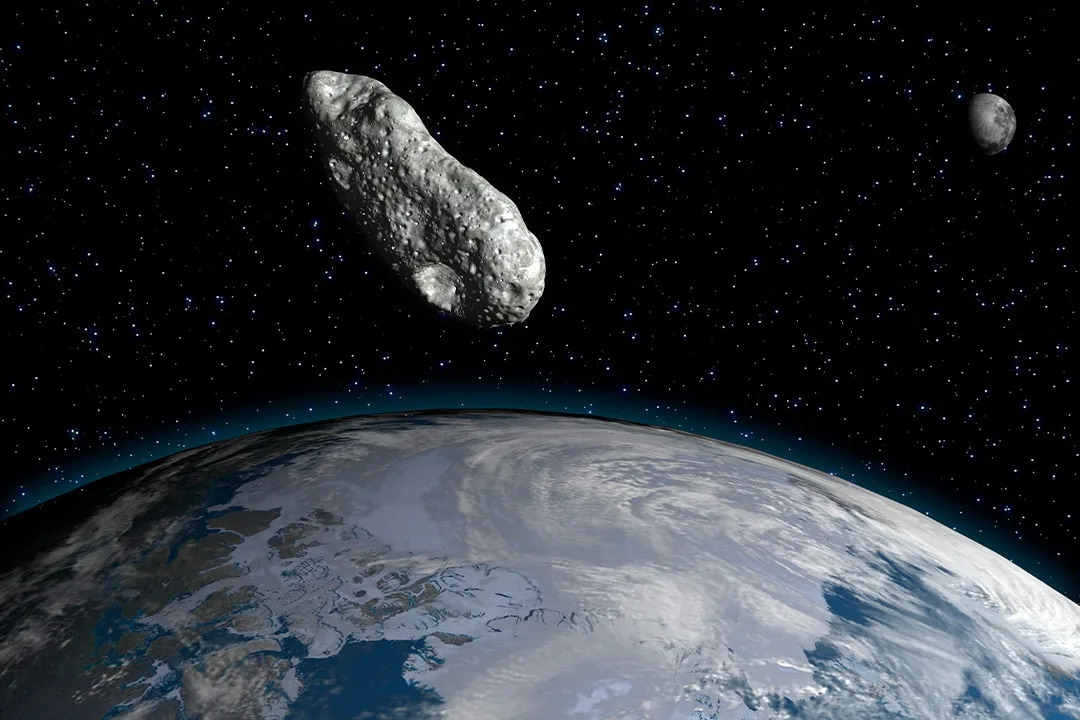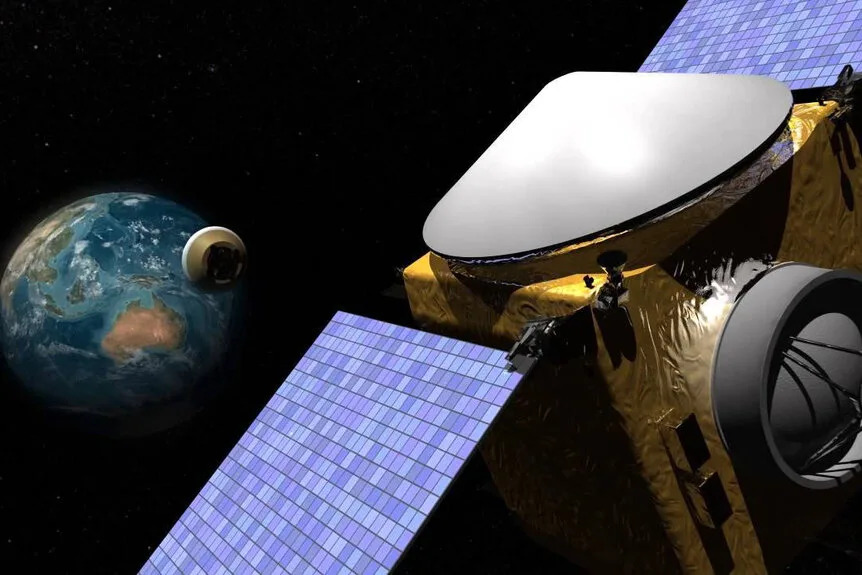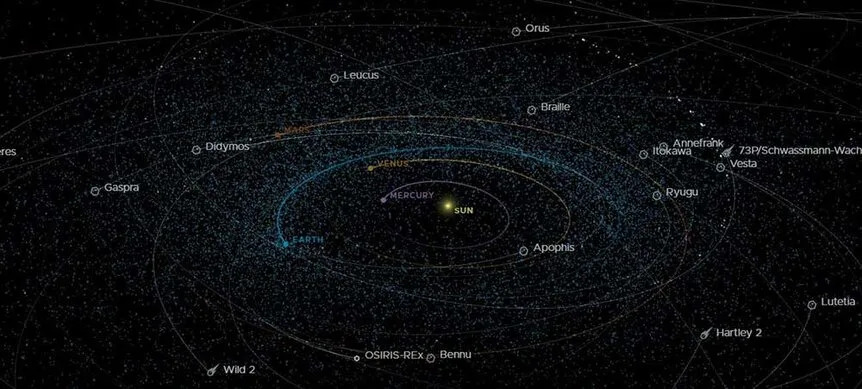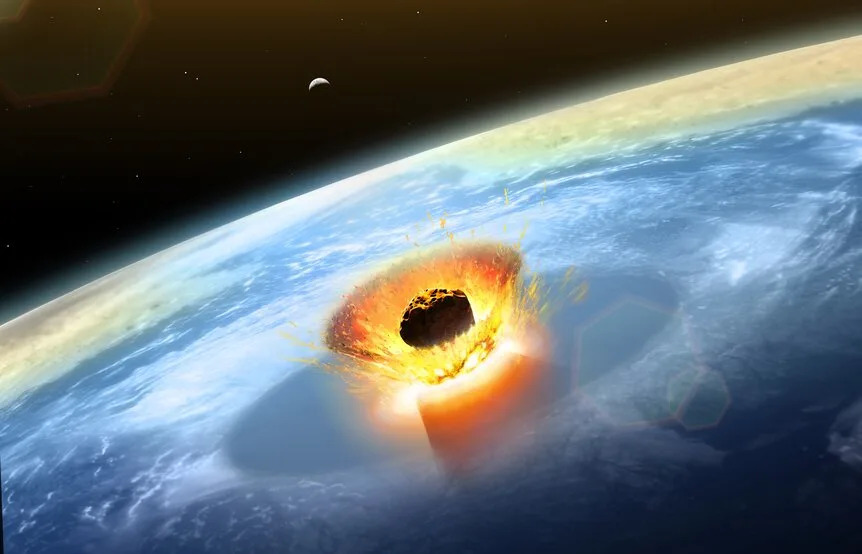Paul Sutter
Wed, December 27, 2023

An illustration of a primitive black hole forming.
Astronomers have figured out how some dying stars kick baby black holes out of the womb — and it's not pretty.
These rare black holes get a significant kick when their parent stars die in a cataclysmic explosion, rocketing the newborn gravitational gluttons out at incredible speeds, a new study found.
The findings could shed light on the enigmatic first moments of a black hole's life.
Black holes and neutron stars are born in the hearts of massive, dying stars. When stars with at least eight times the mass of the sun near the ends of their lives, they fuse iron in their cores. Intense pressures turn that iron core into a proto-neutron star, a clump of neutrons about the size of a city. That clump can temporarily halt the gravitational collapse of the rest of the star. In turn, this stall-out usually triggers a supernova explosion. But pressures can sometimes rise in the hearts of those explosions, smashing that proto-neutron star down into a black hole.
What happens next is anyone's guess. Previous computer models of supernovas simulated only less than a second of that process — just enough to capture the explosion itself. And observations of real black holes and neutron stars suggest all sorts of funky physics. Some neutron stars move at over 3.4 million mph (5.4 million km/h), indicating that they got violently kicked out during the explosion process, while others move 30 times slower, suggesting a more serene birth process.
Black holes, on the other hand, almost always have low "kick" velocities, even though the circumstances of their creation are much more violent.
Related: James Webb telescope discovers oldest black hole in the universe
A team of astronomers elucidated the awkward newborn period of black holes and neutron stars by running 20 computer simulations of supernovas. The simulations ran long enough to show how each object was "kicked" by its parent star. Their work was published to the preprint database arXiv Nov. 20 and has been submitted to The Astrophysical Journal for peer review.
The astronomers discovered a tight relationship between the properties of the parent star prior to the explosion (known as the "progenitor") and the resulting neutron star or black hole. When the parent star isn't very massive and isn't very compact — meaning its outer layers are enlarged relative to its core — the supernova happens very suddenly and in nearly a perfect sphere, leading to a slow-moving neutron star.
On the other hand, very massive, compact progenitors take longer to go supernova, and when the explosions occur, they're not very symmetrical. This produces a fast-moving, kicked neutron star emerging out of the chaos. The researchers also found that larger neutron stars tend to get kicked harder, meaning that more of a compact progenitor's mass in the core winds up in a neutron star.
Progenitors also send neutron stars spinning, and the researchers found that, generally, the greater the kick, the greater the spin. So if the progenitor star exploded asymmetrically, then the irregular explosion not only pushes out the neutron star but also spins it up. This may explain the origins of magnetars, which are rapidly spinning, supermagnetized neutron stars.
Two formation mechanisms explain how black holes get kicked. In one case, the progenitor doesn't fully explode, but the pressure on the core ramps up to the point that a black hole forms. These black holes are rather large — roughly 10 solar masses, on average — and barely get kicked. Most black holes fall into this category.
RELATED STORIES
—Humans could use black holes as batteries, physicists say. Here's how.
—Supermassive black hole at the heart of the Milky Way is approaching the cosmic speed limit, dragging space-time along with it
—Scientists found a way for two black holes to orbit each other forever without colliding
But black holes can also form via a second pathway. In some cases, the progenitor star fully explodes and carries off a lot of mass, leaving behind a smaller black hole of roughly three solar masses. Interestingly, these black holes receive incredible kick velocities, greater than 2.2 million mph (3.6 million km/h), the study found. These fast-moving black holes are quite rare, though.
The research makes an important connection between what we can observe (neutron stars and black holes moving around the universe) and what we can't (namely, the details of the progenitor explosion process itself). By surveying the properties of neutron stars and black holes, astronomers will be able to work toward painting a complete picture of the stellar life cycle.
Earth's intense gravity may rip space rocks apart, reducing the risk of 'planet killer' asteroids
Abha Jain
Wed, December 27, 2023

This graphic shows the orbits of all the known Potentially Hazardous Asteroids (PHAs), numbering over 1,400 as of early 2013.
Every year, dozens of asteroids come closer to our planet than the moon is, and yet catastrophic collisions are exceedingly rare. Now, a new study proposes that Earth has a built-in defense system — its intense gravitational forces — that it uses to tackle asteroid interlopers.
The enormous masses of planets and their moons mean they exert tremendous gravitational forces on nearby objects. The differences in gravity these objects experience, called tidal forces because astronomers used them to explain how the moon causes tides on Earth, can be so strong in some cases that the objects get ripped up ― a process called tidal disruption.
In 1994, space enthusiasts got a firsthand glimpse of the awesome power of tidal disruption when pieces of the comet Shoemaker-Levy 9, torn apart by Jupiter's tidal forces during a close encounter two years earlier, crashed into the gas giant. But for decades, astronomers couldn't find evidence that Earth and other terrestrial planets tidally disrupt passing asteroids or comets.
Related: 'Planet killer' asteroids are hiding in the sun's glare. Can we stop them in time?
Mikael Granvik, first author of the new study and a planetary scientist at Sweden's Luleå University of Technology, has long been searching for these gravitationally ripped-apart near-Earth asteroids (NEAs). "Some ten years ago we looked for families of NEAs that would have formed in such tidal disruptions, but didn't find any," Granvik told Live Science in an email. A follow-up study explained why: Any fragments formed this way would "mix with the background so quickly" that identifying a specific family is impossible, he said.
The hunt for gravitationally torn asteroids remained at a dead end untilGranvik had a flash of insight. In 2016, he helped create a model that calculated the trajectories of asteroids of different sizes to determine their numbers at different distances from the sun.
Granvik and his colleagues compared their model's results with seven years' worth of asteroid observations collated by the Catalina Sky Survey, a NASA-funded Arizona telescope-based program that detects NEAs. But their estimates vastly underpredicted the numbers of certain asteroids ― those spotted at the distances at which Earth and Venus orbit the sun. Most of these missed asteroids were pretty small, chugging along roughly circular paths around the sun, more or less within the same plane as the orbits of Earth and Venus.

With NASA's Eyes on Asteroids, you can watch all the known near-Earth asteroids and comets as they orbit the Sun. Updated twice daily with the latest tracking data, the web-based application will automatically add new near-Earth object discoveries for you to explore.
Then came Granvik's eureka moment. He realized these oddball asteroids could be tidally disrupted fragments of larger asteroids.
To check this idea, Granvik and co-author Kevin Walsh, a researcher at theSouthwest Research Institute in Colorado, considered a scenario where asteroids that encountered rocky planets lost between 50% and 90% of their mass, generating streams of fragments. Now, their model correctly accounted for the previously unexplained asteroids, suggesting they had been created by tidal disruptions. They described the findings in a new study, which has been accepted for publication in The Astrophysical Journal Letters and is available on the preprint database arXiv.
RELATED STORIES
—A skyscraper-size asteroid flew closer to Earth than the moon — and scientists didn't notice until 2 days later
—Could scientists stop a 'planet killer' asteroid from hitting Earth?
—How long can an asteroid 'survive'?
"While individual families are hard to find, the combination of multiple families will produce a signature that we can identify," Granvik said. Additional simulations showed such fragments hung around a really long time, lasting an average of 9 million years before colliding with the sun or a planet or getting kicked out of the solar system.
Tidal disruption caused by Earth may help tackle asteroids, but it creates problems too, by generating more NEAs that are likely to strike our planet. Don't panic, though — because these fragments are smaller than 0.6 mile (1 kilometer) in diameter, "they don't pose an extinction-level threat," Granvik said. However, they do "increase the possibilities for Tunguska-level and Chelyabinsk-level events" — the two largest asteroid impact events in recent history.
NASA Charts Mission to Apophis, the Near-Earth Asteroid Named for the Egyptian God of Chaos
Cassidy Ward
SYFY
Wed, December 27, 2023

NASA Charts Mission to Apophis, the Near-Earth Asteroid Named for the Egyptian God of Chaos
There’s never a good time for an asteroid to hit, but there might be a worst time. In the 2021 film Asteroid (streaming now on Peacock), a family moves from the big city to their new home in the country just before learning that an asteroid is poised to strike that exact spot.
In real life, NASA’s Center for Near-Earth Object Studies (CNEOS) keeps an eagle-eyed watch on the orbiting objects which might pose a threat. They’ve got a list of potential impactors and it’s constantly being updated with new discoveries and up to date orbital information to calculate the probability of a dangerous dust up in the near future. For a while, the asteroid Apophis, named for the Egyptian serpent god of chaos, was public enemy number one (that has since changed with new data) and now NASA is kicking off a mission to visit one of our closest asteroid neighbors.
Wed, December 27, 2023

NASA Charts Mission to Apophis, the Near-Earth Asteroid Named for the Egyptian God of Chaos
There’s never a good time for an asteroid to hit, but there might be a worst time. In the 2021 film Asteroid (streaming now on Peacock), a family moves from the big city to their new home in the country just before learning that an asteroid is poised to strike that exact spot.
In real life, NASA’s Center for Near-Earth Object Studies (CNEOS) keeps an eagle-eyed watch on the orbiting objects which might pose a threat. They’ve got a list of potential impactors and it’s constantly being updated with new discoveries and up to date orbital information to calculate the probability of a dangerous dust up in the near future. For a while, the asteroid Apophis, named for the Egyptian serpent god of chaos, was public enemy number one (that has since changed with new data) and now NASA is kicking off a mission to visit one of our closest asteroid neighbors.
NASA’s OSIRIS-APEX Mission to the Asteroid Apophis

Digital illustration of OSIRIS-REx's Return
OSIRIS-REx Return Photo: NASA
The OSIRIS-Rex mission to the asteroid Bennu successfully wrapped up a few months back when the spacecraft returned to near-Earth space and dropped off a package filled with tiny asteroid rocks. While scientists are busy studying the contents at Johnson Space Center in Houston, the spacecraft is happily bending its path toward its next target.
RELATED: The Asteroid Apophis Isn’t Likely to Hit Earth. But if it Did, What Could we Do?
The original mission was a smashing (literally) success which involved orbiting Bennu for years, mapping the surface, touching down to grab a handful for ourselves, and returning to Earth. When it got back home, the spacecraft’s instruments were still running smoothly, and it had about a quarter of its fuel left in the tank. So, scientists spun up an extended mission to Apophis.
With a new mission and a new name – Origins, Spectral Interpretation, Resource Identification, and Security - Apophis Explorer – the newly dubbed OSIRIS-APEX is on a winding path toward the asteroid Apophis. Meanwhile, Apophis is on its way toward us, and the two will rendezvous during the asteroid’s close pass with our planet in 2029.
The asteroid, which measures approximately 340 meters (1,115 feet) across at its widest point, will arrive in April of 2029 and is expected to pass within 32,000 kilometers (20,000 miles) of the Earth. That’s less than a tenth the distance from here to the Moon. That’s also the closest pass for an asteroid of this size that scientists have ever known was going to happen in advance.
“OSIRIS-APEX will study Apophis immediately after such a pass, allowing us to see how its surface changes by interacting with Earth’s gravity,” said Amy Simon, the mission’s project scientist, in a statement.
OSIRIS-APEX Will Study How Asteroids Change After a Close Pass with Earth

A diagram showing our solar system and the asteroids that surround the Earth
A scientific diagram shows the asteroids surrounding earth. Photo: NASA/JPL/CNEOS
OSIRIS-APEX will start taking pictures of the asteroid’s surface about two weeks before closest approach and it will stay with Apophis for about a year and a half. During that time it will do many of the same things it did at Bennu, gathering scientific data which could help us understand how asteroids form and how they change as they move around the solar system.
The spacecraft will use its onboard instruments to map the surface of Apophis in great detail, much like it did with Bennu. Toward the end of the mission, OSIRIS-APEX will descend to within 16 feet of the surface and fire its thrusters to kick up some dust and get a look at what’s going on beneath the hood. It did something similar at Bennu, using the scattershot effect to gather the sample. The extended mission is operating on the dregs of the primary mission and doesn’t have enough fuel or the hardware required to gather another sample and bring it home. But the science it gathers during and after the asteroid’s close approach will give us unprecedented access to this sort of potentially dangerous interaction.
RELATED: Astronomers Find a Dozen Unexpected Space Objects Way Outside the Kuiper Belt
Between now and April 2029, the spacecraft will circle the solar system getting gravity assists from the Earth and the Sun to move it into position for the arrival of Apophis.
No, Apophis Won’t Hit Earth in 2068

Chicxulub Asteroid Impact
Photo: MARK GARLICK/SCIENCE PHOTO LIBRARY/Getty Images
When Apophis was first discovered, our understanding of its orbit was not well constrained. The possible paths it might take in the future were wide and some of them brought the asteroid into contact with the Earth.
The worry was that the 2029 pass might alter Apophis’ orbit such that it smacked into us on a subsequent lap around the Sun. The 2068 pass had astronomers particularly worried for a little while. However, as previously mentioned, the folks at CNEOS and scientists around the world spend a lot of time checking out objects like Apophis to dial in on what they are doing and what they will do. Thanks to years of additional research, we now know that Apophis won’t strike the Earth for at least the next century. Beyond that, orbits become increasingly difficult to predict and our certainty begins to wane.
“A 2068 impact is not in the realm of possibility anymore, and our calculations don’t show any impact risk for at least the next 100 years,” said Davide Farnocchia from CNEOS, in a statement. “With the support of recent optical observations and additional radar observations, the uncertainty in Apophis’ orbit has collapsed from hundreds of kilometers to just a handful of kilometers when projected to 2029. This greatly improved knowledge of its position in 2029 provides more certainty of its future motion, so we can now remove Apophis from the risk list.”
If you were hoping to recreate Asteroid (streaming now on Peacock) in your own life, you’re going to have to find some other space rock.
No comments:
Post a Comment